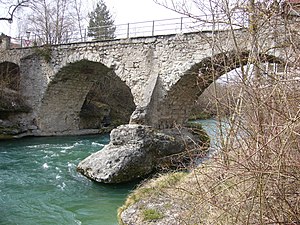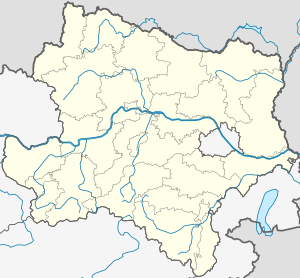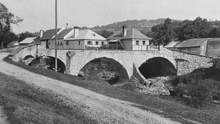Roman Bridge (Scheibbs)
Coordinates: 48 ° 0 ′ 32 ″ N , 15 ° 9 ′ 48 ″ E
| Roman bridge | ||
|---|---|---|
| Roman bridge, seen from the left, western bank | ||
| use | Road, bicycle and pedestrian bridges | |
| Crossing of | Erlauf | |
| place | Scheibbs | |
| construction | Stone bridge | |
| Number of openings | 3 | |
| start of building | 1554 | |
| planner | Johann Valentin Staudinger | |
| location | ||
|
|
||
The Römerbrücke in Scheibbs , formerly also called the Kapuzinerbrücke, was built in 1554 and is the oldest bridge in the municipality of Scheibbs in Lower Austria and also in the entire Erlauftal . For centuries it was the only bridge for miles up and down until the 19th century that crossed the Erlauf and that was made of stone. It was supposed to be torn down around 1870 and replaced by a new building. The bridge is under monument protection ( list entry ).
The Roman Bridge is located one kilometer upstream from another historic bridge, the Heuberg Bridge .
Surname
The tuff rock in the middle of the Erlauf, on which the bridge arches rest, was probably already used by the Romans as a river crossing point, from which the current name can be traced back. Perhaps it is simply due to the design, the sequence of three barrel vaults of almost the same size, a type that the Romans also used for their bridges and aqueducts . The term Roman bridge was generally used throughout Europe for bridges that were built much later, from the Middle Ages , and which visually resemble an ancient Roman bridge.
An earlier name was Kapuzinerbrücke ; Since the first name of the bridge was Steinerne Brücke , which at the time indicates its specialty and exclusivity compared to the usual, cheaper wooden bridges, it is likely that the name "Capuchin Bridge" only came about when the neighboring Capuchin monastery a century later - 1678 - was built on the right bank directly at the bridge.
history
At the place where the bridge is today, there was already a footbridge in 1336; Opposite the bridge is the Steghof, built in 1316, on the left bank of the Erlauf .
The bridge was built in 1554 outside the Scheibbs city walls at the instigation of the Scheibbs citizenship by Johann Valentin Staudinger. The master mason Hans Neuner carried out the construction and charged 215 pounds pfenning. Staudinger was the building supervisor appointed by the city . At that time called the "stone bridge", its construction is evidenced by a breakdown of costs for the bridge construction:
"Make a note of what Joh. Valentin Staudinger received from the masonry Prukhen above the Erlauff under the Markht Scheib for a thousand and fifty hundred and in the fifty-four hundred jars."
The reason for the establishment is not known. Possibly the bridge was an important infrastructure project after the Talenge Peutenburg was blown up in 1544, ten years before that , which had previously prevented heavy traffic with Gaming and Styria . From 1538 there was an increased trade in iron ore , and the previous wooden walkway could no longer have been able to cope with the increasing volume of traffic. In 1561 the infrastructure was completed with the Dreimärkterstraße with Purgstall and Gresten , which only really allowed trade to flourish. The construction of the bridge was therefore an important part of an infrastructure system to cope with the increasing volume of trade.
The three-axis, barrel-vaulted quarry stone building with nose pillars over the tuff rock was originally plastered. The building material came from the tuff quarry in Neustift. Originally, the bridge was provided with stone parapets , which were covered with wooden shingles.
Because of the rocks in the water tightness and low spans the bridge was at high tide again with Verklausungen to fight what the Holztrift was a hindrance. The years 1871–73 were the fateful years of the bridge, as it was at that time that its demolition and its replacement by an iron structure threatened to become a reality. 1869 went reign gaming including timber flotation - privileges to the Actiengesellschaft for forest industry . The timber drift wanted to use this as profitably as possible. The Roman bridge with its central pillar resting on a large conglomerate rock was a major obstacle for the Trift.
First it was about a bridge conversion, in which the rock in the Erlauf should be blasted, the two central arches torn down and replaced by a wide arch without a central pillar. Later, a new plan was presented that called for the entire bridge to be demolished and replaced with an iron truss bridge .
Since the long negotiations were about who should pay what, this variant was intended to make a flat, wide passage appealing to the municipalities. Ultimately, the plans were dropped in 1873 due to a disagreement. In the meantime, however, parts of the central rock under the existing bridge had been blasted. The wooden ice tree was also replaced by a stone nose pillar, the stone parapets removed and replaced with iron railings .
As late as 1853 it is mentioned that there was a statue of St. Nepomuk and a statue of the Trinity on the stone parapets in the middle of the bridge . When these stone parapets were replaced by an iron railing around 1870 in the course of the discussion of a bridge conversion, the Trinity statue was moved in close proximity to the bridge to the Steghof.
The statue of St. John Nepomuk was allegedly later knocked over by a farmer with a cart and pushed into the Erlauf. The rubble was stored for some time in the Steghof and in 1945 the Russians threw it into the Erlauf, where it was washed away by the floods.
The current wooden statue of Johannes Nepomuk was created by the Scheibbs sculptor Josef Lechner (1934-2014) in 1989 and placed on the right bridgehead of the Roman bridge.
literature
- Irene M. Weiß: Bridges and footbridges over the great Erlauf. Association Erlauftaler Bildungskreis. Purgstall, 2003.
- Wilhelm Löwenstein, Hermann Pröll: Chronicle of the district town of Scheibbs. Scheibbs 1989.
Web links
Individual evidence
- ↑ Scheibbser Altstadtrunde: The Roman Bridge in Scheibbs. Retrieved August 5, 2019 .
- ↑ detail. Retrieved August 5, 2019 .










